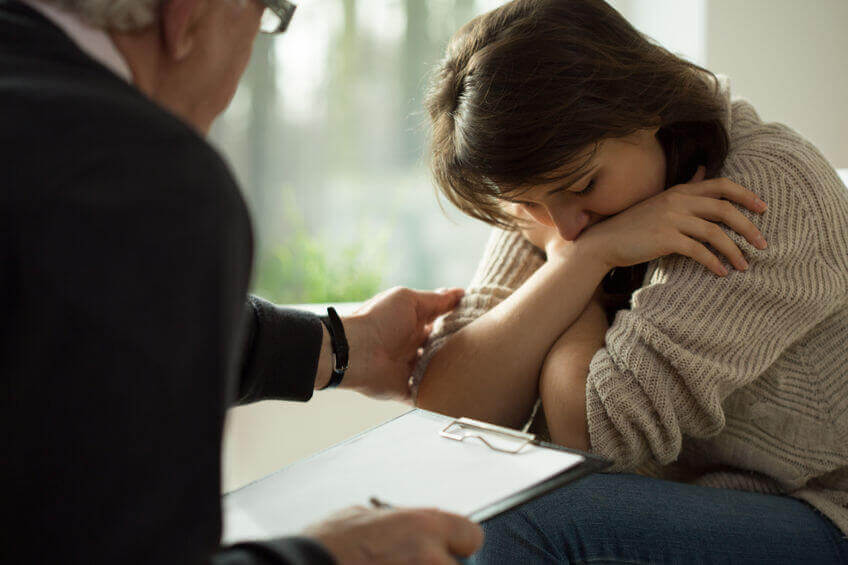Haphephobia: How to Overcome It

Being touched by other people is a general part of social interaction, but haphephobia is a different story. We can all feel uncomfortable when a stranger hugs us or when others invade our personal space. Generally, there’s an appropriate interpersonal distance depending on the type of bond we have with others and if people don’t respect it, we may feel overwhelmed.
However, for those who suffer from haphephobia, a simple handshake or kiss from a loved one is a source of intense discomfort.
Haphephobia is an irrational and pathological fear of touching others or them touching us. The anxiety triggered by physical contact is such that the person may become almost completely isolated in order to avoid such situations. Since humans are social beings, this phobia can seriously interfere with the individual’s daily life.
What are the related symptoms of haphephobia?

Haphephobia falls into the category of specific phobias, so its symptoms are shared with the rest of them. The main ones are the following:
- Intense and disproportionate fear of touching other people or having them touch us.
- Exposure to the feared situation (in this case, physical contact) triggers a strong anxiety reaction.
- The individual is probably aware that their fear is irrational, but can’t control it.
- Situations involving physical contact with others are avoided at all costs and, if not possible, are endured at the cost of enormous discomfort.
- The disorder is prolonged over time and generates interference in the person’s daily life (personal, social, occupational…).
- At the thought of physical contact with other people, physiological symptoms such as tachycardia, sweating, choking sensation or muscular tension appear. It’s also likely that there are irrational thoughts and beliefs about the danger of contact.
Causes and origins of haphephobia
The cause of haphephobia hasn’t been fully established yet and it’s likely that several factors are involved. There may be a certain biological component relating to ancestral fears inherited from our ancestors.
Specific phobias are generally acquired after experiencing related traumatic events either first-hand or witnessing others experience the negative consequences of what subsequently generates fear.
Thus, for example, having a history of sexual abuse in childhood can lead to haphephobia. Similarly, learning that some people have caught a virus through contact with others can trigger this extreme fear of being touched by others.
Risk factors
Not all people react the same way to the same events. Therefore, what for one person may be the origin of haphephobia won’t have a major impact on another. Even so, there are several factors that increase the risk of developing this disorder:
- Having a family history of haphephobia or other anxiety disorders. Firstly, because of the possible inherited genetic component, but also because of having grown up observing people close to you reacting with fear to such situations.
- Having an inhibited temperament and a neurotic or anxious personality.
- Being a woman doubles the risk of suffering from a situational phobia such as this one.
- Having other psychological disorders such as germ phobia, fear of crowds or social anxiety.
Continue reading: Corticophobia or the Fear of Corticosteroids
How do professionals diagnose it?

Professionals base the diagnosis of haphephobia on the fulfillment of the established criteria. That is, a psychologist or psychiatrist must evaluate the symptoms (thoughts, emotions, sensations and behaviors) that the person shows in the face of social contact.
A clinical interview, self-recordings or the use of some appropriate tests and examinations are helpful in this step. This information won’t only help to identify the haphephobia, but also to establish the most appropriate individualized treatment plan.
How you can overcome it
Fortunately, specific phobias respond very well to cognitive-behavioral treatments. These are mainly based on three objectives:
- Equipping the person with strategies to regulate or reduce their level of anxiety. Relaxation techniques and systematic desensitization are the most common options.
- Identify the irrational thoughts that are at the base of the fear and help the patient to reevaluate them. In other words, the patient questions their veracity and replaces them with others that are more functional and real.
- Gradually expose the person to the situations they fear. At the end of the avoidance, experts have verified that the stimulus is actually harmless and it reduces the associated anxiety levels.
- Other alternatives such as mindfulness or acceptance and commitment therapy also show good results. In addition, it’s sometimes advisable to use drugs to support the psychological intervention.
Find out more: Five Mindfulness Exercises for Anxiety
Haphephobia affects daily life
Some phobias don’t generate a huge problem in everyday life, since it’s easy to avoid the feared stimuli. But, in this case, haphephobia fear can limit life on a personal, social, work and emotional level and cause great discomfort.
Because of this and because of the good results obtained with psychotherapy, specialists highly recommend seeking professional help. Undoubtedly, it’s the best option to gain quality of life.
All cited sources were thoroughly reviewed by our team to ensure their quality, reliability, currency, and validity. The bibliography of this article was considered reliable and of academic or scientific accuracy.
- Sánchez Navarro, J. P., & Martínez Selva, J. M. (2009). Reactividad fisiológica periférica y actividad cerebral en las fobias específicas. Escritos de Psicología (Internet), 3(1), 43-54.
- Feliú, M. T. (2014). Los Trastornos de Ansiedad en el DSM-5. Cuadernos de medicina psicosomática y psiquiatria de enlace, (110), 62-69.
- Tortella-Feliu, M., & Fullana, M. A. R. (1998). Una revisión de los estudios retrospectivos sobre el origen de las fobias específicas. Psicología conductual, 6(3), 555-580.
- Bonet, J. I. C. (2001). Tratamientos psicológicos eficaces para las fobias específicas. Psicothema, 447-452.
This text is provided for informational purposes only and does not replace consultation with a professional. If in doubt, consult your specialist.









